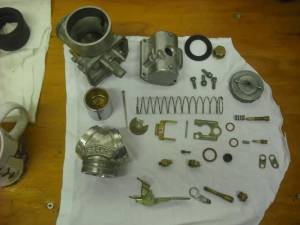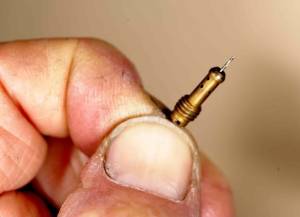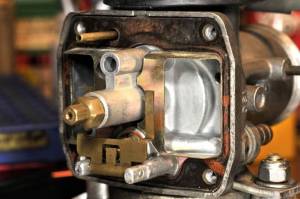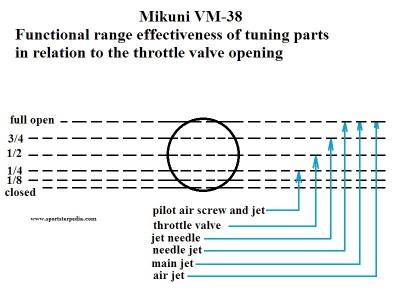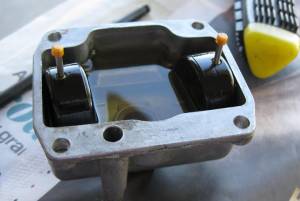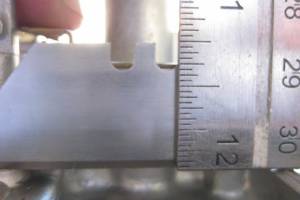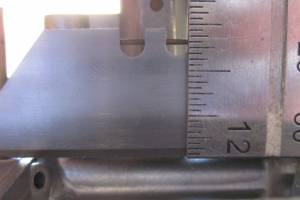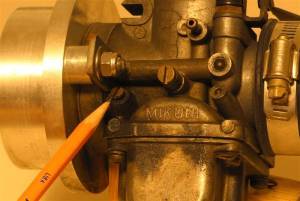Table of Contents
REF: Carburetor, Intake Manifold & Exhaust - Sub-01I
Function and Tuning of a Mikuni VM-38-9
Low-speed Fuel System (pilot system)
Since the engine is operated with the throttle valve almost closed at idle or low speed range, the velocity of air flowing through the needle jet is slow.
A negative pressure strong enough to draw fuel from the needle jet in the main fuel system is not created.
The fuel supply during this low speed operation is controlled by the pilot and bypass.
With the small amount of opening of the throttle valve at idle,
Fuel metered with the pilot jet is mixed with air adjusted in a proper amount by the air screw and is broken into fine particles.
The mixture is again mixed with air coming from the bypass and is drawn into the pilot outlet to mix with air flowing through the main bore.
The fuel mixed with air in the optimum ratio at this stage goes into the engine.
When the throttle valve gets wider for low speed operation, the pilot outlet alone can't supply the required fuel.
So the shortage has to be made up with fuel from the bypass.
Adjusting the mixture ratio during this stage is made by the pilot jet and the air screw, in the case of a 2 hole type system.
A 1 hole type low speed system is mainly used in carbs having a small main bore.
The air/fuel mixture and adjustment is the same as a 2 hole system.
Pilot jet:
The pilot jet should be a #30 and you can access this with the float bowl removed.
It resides down inside the hole in the second pic below above the main jet/main jet holder.
Be sure you use a proper size screwdriver to remove the jet or else you will ruin it and never get it out.
It will have a center hole that a #75 drill bit will go through. A #74 drill bit will not go through.
They say not to use drill bits or wire in a jet but you have to know if it is plugged or not.
On the side of this jet there will be 2 holes, one over the other. These are cross drilled at 90° apart, making a total of 8 holes in the side of the jet.
A #70 drill bit will go those 8 holes.
Main Fuel System
On a Mikuni VM carb, the pilot system and the main system are independent of each other. 4)
There are 2 types of main systems: Primary and Bleed types.
A primary type main system is widely used in 2 stroke applications.
A bleed type main system is used for 4 stroke as well as rotary 2 stroke engines.
Primary type main system: 5)
- When the throttle valve opens by 1/4 or more,
- The velocity of air flowing thru the needle jet increases.
- The negative pressure increases to the point where fuel can be sucked in.
- When the throttle valve opens between 1/4-3/4, fuel passes through the main jet.
- After being metered in the clearance between the needle jet and the jet needle,
fuel is mixed with air that is metered in the air jet and atomization of the fuel is accelerated. - After fuel is mixed with air flowing through the main bore, the mixture is sent to the engine in the optimal air/fuel mixture.
- During this process, the cutaway of the throttle valve serves to control the negative pressure on the needle het.
(thereby regulating the amount of fuel that is sent to the engine)
- When the throttle valve is open more then 3/4 in high speed operation,
- Fuel is mostly metered by the main jet.
Bleed type main system: 6)
- The bleed type system is the same as the primary system with the exception of the bleed hole in the needle jet.
- As in the primary system, air from the air jet is mixed with fuel that is metered in the clearance between the needle jet and the jet needle.
- The bleed type system is designed to hold air in the body of the needle jet and then to have the air/fuel metered.
Jet needle and needle jet:
The jet needle has five notches in it.
The clip on the needle should be in the middle notch. That is third from the top or third from the bottom.
The needle jet is a 166 Q-2 with a single hole.
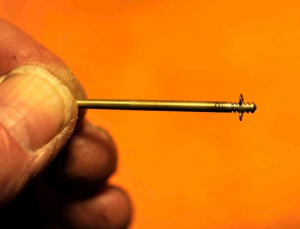 8)
8) 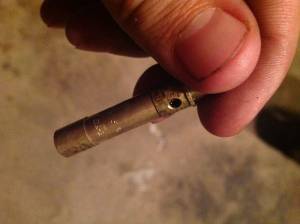 9)
9) 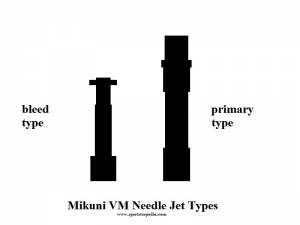 10)
10)
Air jet:
At the A/C end of the carb you will see 3 holes, One at 4:00, one at 5:00, and one at 6:00.
The air jet is either at 5:00 or 6:00 position. Looking down into the hole you should see the brass jet.
It will have a .039“ diameter hole through the jet.
You can stick a #61 drill bit through this small hole to check for blockage. That may be easier than removing the jet.
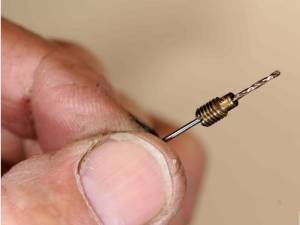 11)
11) 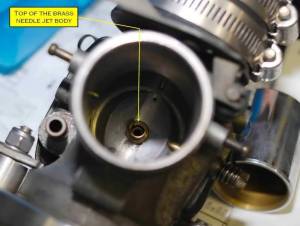 12)
12)
Float
The float serves to maintain a constant level of fuel in the bowl. 13)
Fuel flows between the needle valve and the valve seat and enters the float chamber.
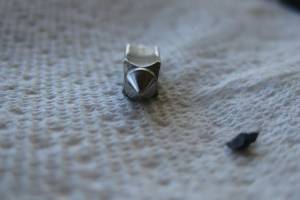 As the fuel enters the chamber, the float moves up to a pre-determined level due to the action of buoyancy.
As the fuel enters the chamber, the float moves up to a pre-determined level due to the action of buoyancy.
You can see the needle valve seat in the left pic below. 14)
When the buoyancy and the fuel pressure balance out, the needle valve (right) is pushed up into the seat to shut off the incoming fuel supply. 15)
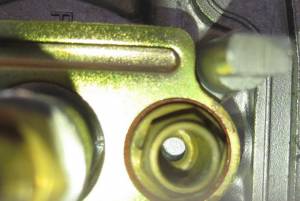 The fuel level in the bowl controls the amount of fuel in the fuel mixture.
The fuel level in the bowl controls the amount of fuel in the fuel mixture.
Too high a level allows more fuel than necessary to leave the nozzle thus richening the mixture.
Too low a level allows not enough fuel than required to leave the nozzle thus leaning out the mixture.
Therefore the pre-determined float level should not be changed arbitrarily.
There is a float bowl baffle plate in the carb which is there to prevent air bubbles from forming in the float chamber. 16)
Air bubbles in the float bowl would affect the fuel mixture going into the jets.
Some VMs have 1 float while others have 2 of them.
On this particular set of floats, one side of the float tang is set at 21/32”, the other side of the float tang is a little lower at 20/32“.
Enrichment (starting) System
The Mikuni VM does not have a choke. Instead it uses a 'starter system' (more recognized as an enricher). 20)
Fuel and air for starting the engine is metered with entirely independent jets.
The metered fuel in the starter jet is mixed with air and broken into tiny particles in the emulsion tube.
The mixture then flows into the plunger area mixes again with the air intake port for starting.
Then it is sent to the engine in the optimal air/fuel ratio through the fuel discharge nozzle.
The starter is opened and closed by use a starter plunger (not to be confused with a choke knob).
Since the starter uses the negative pressure of the inlet pipe, it is important that the throttle valve is closed when starting the engine.
At temps above 68°F, the engine can be started without the enricher.
Tuning and Adjustments
Adjusting the air screw
When the settings are not correct, various symptoms are noticed. 21)
- Running rich:
- Engine noise is dull and intermittent
- Condition grows worse with the enrichner opened.
- Removingtheair cleaner will help somewhat.
- Exhaust gasses are heavy.
- Spark plug may foul.
- Running lean:
- The engine gets overheated.
- Condition improves with the enrichner open.
- Poor acceleration.
- Spark plug burns.
- The revolution of the engine fluctuates and lack of power is noticed.
The air / fuel mix ratio is generally expressed by the weight proportion. 22)
In theory, the amount of air required for complete combustion of 1 gram of fuel is 15 grams of fuel per 1 gram of air (or 15/1).
In reality, varying mixture ratios are required for the engine depending on conditions.
Although the required mixture ratio varies per engine, in the high speed range, 12/1 or 13/1 produces the most power.
However, in the case of an engine with low cooling efficiency, 10/1 to 12/1 mix ratio may help to prevent engine seizure.
The air screw needle adjustment is on the side as indicated with the pencil in the pic below.
Turning the needle in richens the mixture. Turning the needle out leans the mixture.
About 1-1/2 to 2 turns out should be about right. But you'll have to conclude that yourself.
It's a good idea to adjust the valves BEFORE trying to adjust the carb setting. The engine must be stone cold for any valve adjustments.
When you have done the best you can with the adjustment, you are done.
- Screw the Air Screw in until it touches the seat lightly (closed) then turn it out 1 turn. 23)
Note: The most this screw can be turned out is 3 turns. Beyond that the spring will no longer hold pressure and the screw will fall out.
- Start the bike and let it warm up fully.
Obtain a nice smooth idle with the idle adjustment screw. 24)
Set it 10% to 15% higher than you would like a normal idle speed to be. - Then begin turning the Air Screw inward or outward slowly (no more than a 1/4 turn at a time).
- What you are looking for is to find the place where the engine speed is the greatest.
- When you get to that place, reduce the idle speed to a normal idle.
You're not through yet.
Do the adjustment exercise one more time.
- If you find the idle speed increases (let's say at 1-1/2 turns out) but stays at the same speed until you are two turns out and then it falls off;
- Turn the screw back to the 1-1/2 turn position and this is the correct adjustment.
If your final adjustment leaves you with the air speed needle being turned right or left with no change in idle speed, then favor the right position (richer) rather than the leaner position (to the left).
- Now set the final idle speed if needed.
Unless you have other problems this adjustment should fix the carb and running problems.
The high idle should respond to turning out the idle screw. 25)
If the idle speed does not drop when you unscrew the screw, then you may have an air leak at the manifold O-rings.
There is nothing else that could be causing the fast idle unless the slide was truly worn out, and that is not likely on a Mikuni with the heavy brass slide.
Troubleshooting
Can't get the engine to idle
Make one change at a time. If you do several things at once all that is going to happen is confusion. 27)
Take it one step at a time and put the fires out as they present themselves.
Do not try doing 6 things at once and having no idea if you're moving forward or backward.
It's easy to get impatient and an ironhead will always win out in that situation.
So begin by getting the engine to start. Everything else follows this.
- Make sure the battery is fully charged.
- Check for an intake manifold leak air leak. This will make starting very difficult.
- Forget about the timing for now. Just make sure the hold down screws on the points backing plate are in the middle of the adjustment slots.
That is going to be close enough to start the engine. - Next, check to make sure the engine is getting spark.
- Turn the air screw in lightly until it seats, then back off 1 turn.
- Push down the enrichment lever (on position).
- Turn the engine over (with either kick start or electric start) and give it NO THROTTLE at all.
- The engine should start. After you warm up the engine fully you can set the ignition timing if you so desire.
- The carb adjustment comes next by setting the air screw.
- If for some reason the engine does not start, then you need to pull the plugs and see if they are wet with fuel.
If fuel is present and spark is present as well, then remove the carb and manifold and check to make sure the O-rings on the manifold are sealing.
Can't get the engine to start
If this is a carb issue and if you are getting fuel to the cylinders and you are getting spark at the plugs, it should start. 28)
- Make sure the petcock is open.
- Check the manifold O-rings for leaks: 29)
- Remove the carb and feel inside the manifold with using your finger.
- The surface of each O-ring must be smooth and the same all the way around the surface.
- If you feel any irregularity of the surface, you have an air leak and this condition will cause the engine not to start.
- You can try using some starter fluid.
- Remove the air cleaner.
- Open the throttle wide raising the slide and give a good shot of starter fluid into the throat.
- Quickly, so the fluid does not evaporate, start kicking the engine over.
- If it does not start, you have ignition problems.
The starter fluid plus air equals a start, it does not really need a carb for this because the fluid ignites.
Shortly the fluid will be consumed and then the carb should be working.
See the 'helpful links' at the bottom of the page for a video of starting a 1971 ironhead after it had sat for a year without starting.
The bike is kick start only, so it was hell.
However, the video is about 10 minutes and very painful to sit through.
Please understand this, my machine is in perfect tune. The bike gets perfect spark. and delivers gas perfectly from the Bendix that was on it at the time.
Yet it would not so much as pop. It was kicked over 30 times before it would pop.
Using starting fluid, nothing happened.
Finally after spraying fluid down the throat of the carb and quickly jumping on the starter, the bike fired right up.
What was happening was the fluid was sprayed and too much time was taken before trying to fire up the engine.
This let the fluid evaporate before kicking it over. So try your machine with starting fluid and see if that won't get it going.
Flooding
When you have a flooded engine, you want to take the enricher off and open the throttle wide open.
Then kick or hit the starter button to see if it will fire off.
The reason you open the throttle wide open is to balance all that gas inside the cylinder with a lot of additional air.
Once the mixture balance reaches 15:1 (air to fuel) ignition will happen.
The VM 38-09 setup should not be flooding the engine unless the float level is wrong.
If yours is not set up as a 38-09, you may have problems with the carb.
If this persists:
- Check you petcock and line to the carb.
If you don't have a strainer then you'll need to run an inline filter.
- Also make sure you turn the petcock off every time you shut the engine down.
Else gas will continue to drain from the tank through the carb / rings and into the crankcase.
Then you may end up with gas and oil blowing out the crankcase breather tube. 30)
- Check the sir screw adjustment.
- Pull the float bowl off and see if there is anything stopping up the inlet seat or sitting in the bottom of the bowl.
- Never open the enricher while after the engine is at operating temp and idling. It'll kill the engine and flood the overflow hose. 31)
It's not a choke and it's technically called a 'Starter System' and is just that….. for starting the engine.
The starter System uses an enriched mixture and a flood of fuel is the result.
The starter system works with a vacuum, so that is the reason you are to give it absolutely no throttle when you start the engine. Use the lever each time you start the engine, regardless if the engine is warmed up, or not warmed up.
KEEP YOUR HAND OFF THE THROTTLE WHEN STARTING. After the engine fires up, move the lever to the off position.
Here, a piece of fuel hose was found hung up into the float valve causing flooding.
 32)
32)
Helpful Links
- Air Cleaner Basics, Exhaust System Basics, Cam Basics and Ignition Basics
Video:

